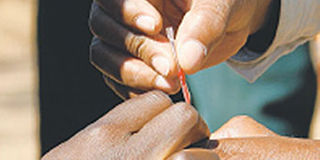Baby’s negative HIV test results shock doctors

Doctors say that two HIV tests done on a six-month-old’s blood samples using the Polymerase Chain Rectors (PCR) have returned negative results. Photo/FILE
An HIV positive woman has delivered an HIV negative baby without any medical intervention.
The baby has tested negative for the virus on the most advanced machine used in diagnosing HIV.
This is despite her mother not having used any anti-retroviral drugs or other forms of interventions key in preventing the virus from passing to the child during pregnancy.
Doctors say that two HIV tests done on the six-month-old’s blood samples using the Polymerase Chain Rectors (PCR) have returned negative results.
“Before delivery, we followed her for several months to ensure her viral load was below detectable levels and the CD4 count was in the permitted range for a healthy person,” says Dr Surendra Patel, a researcher and an expert in infectious diseases.
By the time the woman was giving birth to her 2.6-kilogramme baby, the doctor says, her viral load (the amount of the active HIV in a person’s blood) was below 20 copies or an undetectable level, and the CD4 count (immune cells that fight infections) was over 600.
The normal CD4 range for a healthy functioning immune system is between 600 and 1,500 cells per cubic millimetre.
“Our fingers were crossed as she went into labour and gave birth. But the negative HIV results from the tests we have done so far on the baby are very encouraging and telling,” says Dr Patel, who is also an adjunct professor at the University of Nairobi’s College of Biological and Physical Sciences.
The baby born at Nairobi’s MP Shah Hospital last August, he adds, will be followed for a year to ensure everything is fine.
“The tests we have done so far are sufficient to convince us that the baby is indeed HIV negative. The follow-up is critical to inform the observations we are making on the mother,” he says.
The mother, who is in her 30s, was reluctant to be interviewed, saying she was afraid of the attention the media might accord her if she goes public.
Besides this, some of her family members and workmates do not know her HIV status.
Nevertheless, the story of her HIV negative baby has far-reaching implications on policy and research in regard to the management of HIV and handling of HIV positive mothers whose CD4 count are above 600 and viral load at undetectable levels.
The current practice requires HIV positive pregnant women to be put on ARVs, breastfeed exclusively for six months, and use other interventions such as birth by Caesarean section to significantly reduce the chances of passing the virus to the baby.
The use of exclusive breastfeeding to reduce the HIV transmission rate is informed by studies.
Findings of a recent study conducted by scientists at the Africa Centre for Health and Population Studies, South Africa, and published last year in the Lancet medical journal, found the risk of HIV infection for infants aged between six weeks and six months who were breastfed exclusively was four per cent.
The risk for those who received formula milk was about twice this, while those babies getting breast milk together with solid foods were 11 times more likely to get HIV.
Breast milk is known to strengthen the mucous membrane within the intestines, providing an effective barrier to HIV infection.
On the other hand, past research has indicated that proteins found in solid foods may result in greater damage to the linings of the stomach, making it easy for the virus to penetrate.
Increased efficacy of drugs
Use of ARVs reduces the mother’s viral load to very low levels, cutting down the chances of transmission. When combined with Caesarean section, the efficacy of the methods is even higher.
That is why many HIV positive women who use ARVs are giving birth to HIV negative children.
But with the birth of an HIV negative baby by this mother without any of these interventions, this new development is likely to indicate that women with CD4 and viral load at certain levels may not need to invest in some of these interventions.
They can also simultaneously breastfeed and feed their babies with solid foods without the risk of infecting them with HIV.
Dr Patel and other scientists are trying to understand how the “miracle” mother’s immune system suppressed the replication of the HIV, keeping it at undetectable levels.
This knowledge is likely to improve the design of Aids vaccines. The research is expected to be complete in 12 months.




